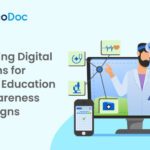Introduction
Oncology is advancing at an unprecedented pace, driven by breakthroughs in immunotherapy, targeted therapies, and personalized medicine. New treatment paradigms such as CAR-T cell therapy, bispecific antibodies, and liquid biopsy technologies are reshaping cancer care, making it imperative for oncologists to stay updated with the latest evidence-based strategies.
Traditionally, oncologists relied on medical journals, conferences, and in-person workshops for continuing medical education (CME). However, the rapid expansion of digital platforms has revolutionized the way medical knowledge is disseminated. Webinars, in particular, have emerged as a powerful tool for oncologists seeking to stay abreast of cutting-edge advancements while managing their demanding schedules.
“This article explores how webinars have transformed oncology education, offering an accessible and interactive learning experience for healthcare professionals.”
The Growing Role of Webinars in Medical Education
Webinars have become an integral component of medical education, bridging the gap between theoretical knowledge and clinical practice. Unlike passive forms of learning such as reading journal articles or watching pre-recorded lectures, webinars allow for real-time engagement with leading experts, fostering discussions that can directly impact patient care.
Benefits of Webinars for Oncologists
1) Convenience & Flexibility:
· Oncologists can attend live sessions or access recorded versions later, accommodating their unpredictable schedules.
· Eliminates the need for travel, reducing disruptions to patient care.
2) Real-Time Interaction & Peer Networking:
· Live Q&A sessions enable oncologists to seek expert opinions on challenging cases.
· Facilitates networking with global oncology experts and peers.
3) Cost-Effective Alternative to Traditional CME:
· Unlike expensive conferences, many webinars offer free or low-cost access, ensuring continuous learning without financial barriers.
· Hospitals and institutions save costs while ensuring their oncologists remain updated.
4) Immediate Access to the Latest Research & Guidelines:
· Webinars often feature live case discussions, clinical trial updates, and new guideline recommendations. For example, recent updates from ASCO’s annual meeting on immunotherapy and targeted therapies have been key discussion points in webinars.
· Provides practical insights into integrating emerging therapies into clinical workflows.
Webinar Impact: Key Metrics and Engagement Insights
a) Webinar Participation & Engagement Overview
Webinar participation rates reveal a high level of engagement among oncologists, with significant retention and interaction post-event.

High engagement, with a 75-80% attendance rate and 75% post-webinar interaction, indicates the strong relevance of content. The presence of 13,000 active users suggests sustained interest and retention.
b) Monthly Webinar Trends and Consistency
Tracking the number of webinars conducted per month and their average duration provides insights into consistency and frequency.

Hosting 12-15 webinars per month ensures continuous learning opportunities. The 45-minute session format optimizes engagement, and trend analysis can refine scheduling for future webinars.
c) Webinar Topics and Registration Trends
Oncologists are most interested in cutting-edge developments and practical clinical applications.

The highest registration numbers reflect oncologists’ strong interest in both holistic treatment approaches and the latest advancements in breast cancer therapy.
Key Takeaways
- High Engagement: A majority of oncologists actively attend and engage in webinars.
- Enhanced Knowledge Retention: Interactive learning fosters better knowledge retention than passive methods.
- Direct Clinical Impact: Expert-led discussions provide oncologists with actionable insights for evidence-based treatment decisions.
Why Do Oncologists Prefer Hidoc?
Hidoc has 13,000 active users and 20,000 registered oncologists, making it one of the leading digital resources for cancer specialists.
Here’s what sets it apart:
1. Personalized webinars: on the latest cancer treatments, such as PD-1 inhibitors, PARP inhibitors, and bispecific antibodies.
2. High Engagement: With a 75% engagement rate after webinars and an 80% attendance rate.
3. User-Friendly Platform: Oncologists can easily access and engage with content on Hidoc, even during their busy clinical hours, thanks to its intuitive interface.
“Hidoc’s oncology-focused webinars report a 75% engagement rate, indicating their role in delivering structured, high-quality education for specialists.“



